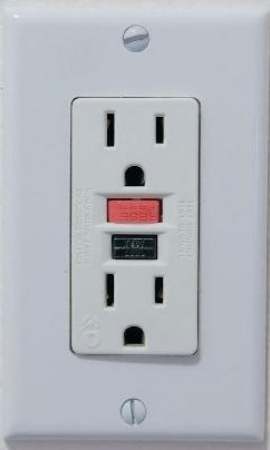GFCI: The Silent Savior
ne of the biggest electrical safety projects you can do for your home is adding GFCI’s. GFCI’s should be located in areas where water is found or might be under certain conditions.
A GFCI or Ground Fault Circuit Interrupter can detect tiny changes in the electrical current and responds to those changes. Within a percentage of a second, a GFCI will shut down the power to the outlet in question, which stops the flow of electricity.
Many people now seek more ready access to electrical outlets as the result of Smart devices. A GFCI/light switch combo is the perfect solution.
How a GFCI works
GFCI’s are amazingly useful because they detect overloads and shorts. They do this by measuring how much electrical current is moving from hot to neutral. This measurement can save a person who is in contact with this electricity from getting shocked or electrocuted. Shock by itself may not kill you. But, a shock from only a minute amount of power can cause heart fibrillation, and it’s the heart fibrillation that can kill you.
Why have a GFCI in the bathroom?
The reason GFCI’s are located in areas where water might be present is that when electrical circuits might come in contact with water through a person. Lots of people don’t realize the danger of mixing moisture and electricity in the innocuous setting of their kitchen or bathroom because standing on a wet floor or mat after a shower happens quite frequently, so it might not be obvious not to use an electric curling iron if the floor is still wet. Oddly enough, it only takes a tiny amount of electrical current from one of these situations to cause fibrillation.
By contrast, an electrocution is a form of being burned. Burns from an electrocution might or might not kill a person, but they can be horrible and it could be a long, slow recovery.
Child safety
In addition to people who get caught between water and electrical current, there are also curious children who are entirely unaware of the dangers of electrical power. They can manage to poke things into electrical outlets in an extraordinarily short amount of time. A GFCI will detect the change in current from the foreign object and shut the power off.
Electrical code
Electrical code requires GFCI’s to be in kitchens, bathrooms, laundry rooms, garages, and outdoors since these are all areas where water is likely to be present. If your home is over 20 years old, it may not have GFCI’s. Adding them to appropriate areas would be a significant safety upgrade. The numbers of people who are treated for shock have been reduced substantially since the advent of the GFCI.
Test, reset, replace
If you have a GFCI and the reset button pops on it, there has been an electrical event, and it needs to be reset. During periodic testing maintenance, the button pops, and it can be reset. If it won’t reset, it needs to be replaced. GFCI’s are somewhat sensitive, which is the way they were designed, so if the outlet needs to be frequently reset, it should be replaced.
A GFCI which is on a closed circuit can shut power to all of the electrical plugs on that circuit in the event of an electrical anomaly. So, for example, a toaster falls into the sink full of water, and that outlet doesn’t have a GFCI, but one of the other outlets on the same circuit has a GFCI, the GFCI breaker will trip, and the power ceases.
A GFCI should be tested monthly to make sure it’s in good working order.
If you need a highly-reviewed, licensed electrician in the Phoenix Valley area, call Efficient Electric at 623-810-9905. We would love to hear from you!


